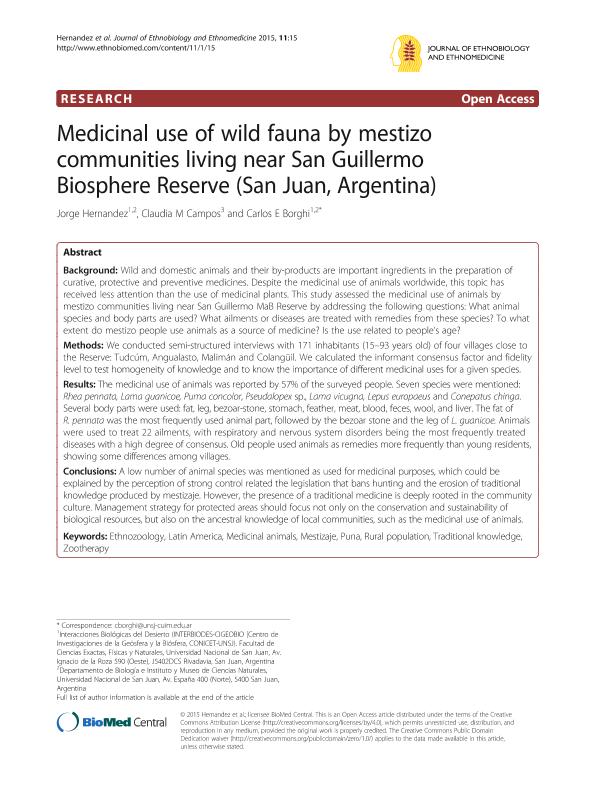Mostrar el registro sencillo del ítem
dc.contributor.author
Hernández, Jorge
dc.contributor.author
Campos, Claudia Monica

dc.contributor.author
Borghi, Carlos Eduardo

dc.date.available
2016-04-11T14:37:29Z
dc.date.issued
2015-01-21
dc.identifier.citation
Hernández, Jorge; Campos, Claudia Monica; Borghi, Carlos Eduardo; Medicinal use of wild fauna by mestizo communities living near San Guillermo Biosphere Reserve (San Juan, Argentina); BioMed Central; Journal of Ethnobiology and Ethnomedicine; 11; 15; 21-1-2015; 1-10
dc.identifier.issn
1746-4269
dc.identifier.uri
http://hdl.handle.net/11336/5112
dc.description.abstract
Background: Wild and domestic animals and their by-products are important ingredients in the preparation of curative, protective and preventive medicines. Despite the medicinal use of animals worldwide, this topic has received less attention than the use of medicinal plants. This study assessed the medicinal use of animals by mestizo communities living near San Guillermo MaB Reserve by addressing the following questions: What animal species and body parts are used? What ailments or diseases are treated with remedies from these species? To what extent do mestizo people use animals as a source of medicine? Is the use related to people’s age?
Methods: We conducted semi-structured interviews with 171 inhabitants (15–93 years old) of four villages close to the Reserve: Tudcúm, Angualasto, Malimán and Colangüil. We calculated the informant consensus factor and fidelity level to test homogeneity of knowledge and to know the importance of different medicinal uses for a given species.
Results: The medicinal use of animals was reported by 57% of the surveyed people. Seven species were mentioned: Rhea pennata, Lama guanicoe, Puma concolor, Pseudalopex sp., Lama vicugna, Lepus europaeus and Conepatus chinga. Several body parts were used: fat, leg, bezoar-stone, stomach, feather, meat, blood, feces, wool, and liver. The fat of R. pennata was the most frequently used animal part, followed by the bezoar stone and the leg of L. guanicoe. Animals were used to treat 22 ailments, with respiratory and nervous system disorders being the most frequently treated diseases with a high degree of consensus. Old people used animals as remedies more frequently than young residents, showing some differences among villages.
Conclusions: A low number of animal species was mentioned as used for medicinal purposes, which could be explained by the perception of strong control related the legislation that bans hunting and the erosion of traditional knowledge produced by mestizaje. However, the presence of a traditional medicine is deeply rooted in the community culture. Management strategy for protected areas should focus not only on the conservation and sustainability of biological resources, but also on the ancestral knowledge of local communities, such as the medicinal use of animals.
dc.format
application/pdf
dc.language.iso
eng
dc.publisher
BioMed Central
dc.rights
info:eu-repo/semantics/openAccess
dc.rights.uri
https://creativecommons.org/licenses/by/2.5/ar/
dc.subject
Ethnozoology
dc.subject
Latin America
dc.subject
Medicinal Animals
dc.subject
Mestizaje
dc.subject
Puna
dc.subject
Rural Population
dc.subject
Traditional Knowledge
dc.subject
Zootherapy
dc.subject.classification
Ciencias Biomédicas Sociales

dc.subject.classification
Ciencias de la Salud

dc.subject.classification
CIENCIAS MÉDICAS Y DE LA SALUD

dc.title
Medicinal use of wild fauna by mestizo communities living near San Guillermo Biosphere Reserve (San Juan, Argentina)
dc.type
info:eu-repo/semantics/article
dc.type
info:ar-repo/semantics/artículo
dc.type
info:eu-repo/semantics/publishedVersion
dc.date.updated
2016-05-06 15:52:43.262787-03
dc.journal.volume
11
dc.journal.number
15
dc.journal.pagination
1-10
dc.journal.pais
Reino Unido

dc.journal.ciudad
Londres
dc.description.fil
Fil: Hernández, Jorge. Universidad Nacional de San Juan. Facultad de Ciencias Exactas Físicas y Naturales; Argentina. Consejo Nacional de Investigaciones Científicas y Técnicas. Centro Científico Tecnológico San Juan. Centro de Investigaciones de la Geosfera y Biosfera; Argentina
dc.description.fil
Fil: Campos, Claudia Monica. Consejo Nacional de Investigaciones Científicas y Técnicas. Centro Científico Tecnológico Mendoza. Instituto Argentino de Investigaciones de Zonas Aridas; Argentina
dc.description.fil
Fil: Borghi, Carlos Eduardo. Universidad Nacional de San Juan. Facultad de Ciencias Exactas Físicas y Naturales; Argentina. Consejo Nacional de Investigaciones Científicas y Técnicas. Centro Científico Tecnológico San Juan. Centro de Investigaciones de la Geosfera y Biosfera; Argentina
dc.journal.title
Journal of Ethnobiology and Ethnomedicine
dc.relation.alternativeid
info:eu-repo/semantics/altIdentifier/url/http://ethnobiomed.biomedcentral.com/articles/10.1186/1746-4269-11-15
dc.relation.alternativeid
info:eu-repo/semantics/altIdentifier/url/http://www.ncbi.nlm.nih.gov/pmc/articles/PMC4417256/
dc.relation.alternativeid
info:eu-repo/semantics/altIdentifier/doi/http://dx.doi.org./10.1186/1746-4269-11-15
dc.relation.alternativeid
info:eu-repo/semantics/altIdentifier/url/http://link.springer.com/article/10.1186%2F1746-4269-11-15
dc.relation.alternativeid
info:eu-repo/semantics/altIdentifier/doi/10.1186/1746-4269-11-15
Archivos asociados
